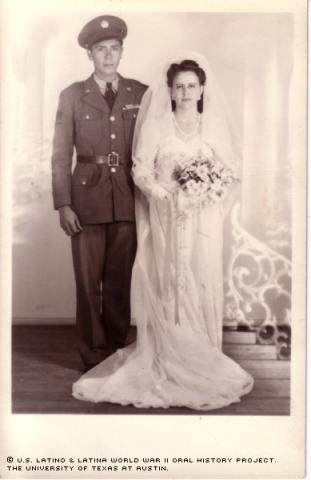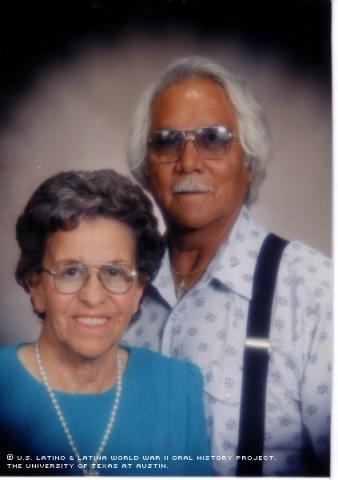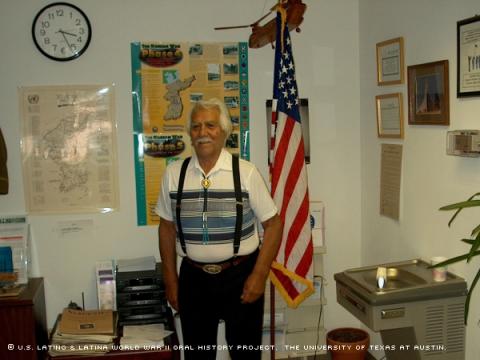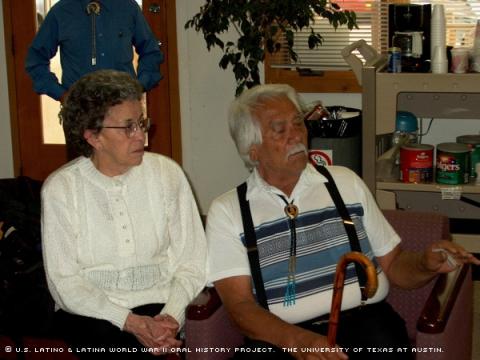



By Jason McDaniel
Luis Sena was only 6 years old on Black Thursday, the day the stock market crashed and sent the American economy spiraling into the Great Depression. His father had died four years earlier, in 1925, leaving Luis' mother, Maria Sanchez Sena, to care for him and his seven siblings.
Those two events set the tone for what would be a difficult childhood for the Senas in Golondrinas, a small town in Mora County, New Mexico.
"There were days when I had to eat gravy, just made out of water and a little flour, with no bread, just a spoon," Sena said.
Although life was hard for many Americans, it was particularly difficult for Latinos trying to find work. More often than not, there wasn't any, especially during the winter. Sena says he and his four brothers would take jobs on farms in the area for 25 cents a day. He quit school during the sixth grade to herd sheep for $20 a month, a good job by the standard of the times.
But still it wasn't enough. It was only the hard work of his mother that kept the family from starving. So, when Sena turned 18 on August 11, 1941, he says he decided to do what he could for the family: He volunteered for the Army.
By serving in the military, he’d be guaranteed a regular paycheck; it was the only way he could think of to help the family earn enough to keep eating. So, on September 27, in the fall before the Japanese attacked Pearl Harbor, Sena was inducted into the Army.
After joining, he spent eight days at Fort Bliss in Texas, before heading to Camp Roberts in California to begin his training. He hadn't even finished learning how to fire his weapon, however, when that training was abruptly cut short.
After the devastating attack at Pearl Harbor, Sena was sent to Fort Lewis in Washington. He spent time guarding bridges along the coast near Anacortes and Burlington, where he spent his first Christmas away from his family. Before long it became apparent the Japanese weren't going to attack Washington, so Sena was moved again. This time, it was a much more dangerous assignment.
His unit, Co. L of the 163rd Infantry Regiment, 41st Infantry Division, went to Australia for brief training. Then Sena, who was only 18, was sent to fight in the jungles of New Guinea. During a 34-month span he fought with the Allied forces in numerous campaigns on the islands of New Guinea and helped drive the enemy out of Buna and Gona during the Papuan campaign.
While in New Guinea, the soldiers had to fight mosquitoes as well. Malaria was rampant, and Sena fell victim. He spent 10 days in a hospital, quarantined with a 107-degree temperature.
When he recovered, it was back to the war. Then he had his closest call of all.
On July 10, 1944, Sena was in the middle of a skirmish. He was kneeling behind a tree when a Japanese soldier with a bazooka, or a rifle grenade, fired toward his hiding spot. The shell exploded close by, hurling shrapnel straight toward him.
"All of a sudden I felt something hot running down my chest and my hand, so I unbutton my jacket and sure enough, I was bleeding from 11 places. I still have a piece of shrapnel in my hand and two pieces in my chest," said Sena, pointing to his left hand.
That incident landed him in the hospital for a month and earned him the Purple Heart. When he’d recovered enough, he was sent back to his company to fight.
Finally, in December of 1944, Sena was sent back to the States. He says the only reason he made it back was because God was with him.
"If you came back, it was only because of God's help, not because you were lucky," he said.
Sena arrived in San Francisco on the evening of Dec. 28, 1944. Many years later, in 1985, he was awarded his Bronze Star Medal. He also earned a Good Conduct Medal, an American Defense Service Medal, an Asiatic-Pacific Service Medal with campaign stars for Papua and New Guinea, and a Distinguished Unit Badge for his time overseas.
When Sena saw his mother back home in New Mexico, the first thing he asked for was homemade tortillas, which he hadn't eaten in more than three years. Soon after he returned to the U.S., he met his wife, Elvira Trujillo, at a dance near Las Vegas, N.M., 50 miles north of Santa Fe. Within a month, they were married.
Sena was officially discharged August 18, 1945, at the rank of Private First Class. He was able to attend a vocational school by uning his GI benefits. He learned how to make boots and saddles and spent a year studying carpentry and two years learning cabinet-making. During that time, he and Elvira welcomed the first of their five children.
All of the skills he learned in school served as hobbies later in life when his career path led him elsewhere.
After he finished school, Sena took a job with the U.S. Postal Service, where he worked for five years before resigning to take a job for the New Mexico Highway Department, operating bulldozers, front-end loaders and driving water trucks. He also spent time working as a janitor and one year at the Air Force Academy in Colorado Springs, Colo., working as a landscaper. In his last job before retiring in 1988, Sena drove a mail truck back in Las Vegas. Elvira worked as a licensed practical nurse for the state of New Mexico for 30 years.
Sena says he now spends his time working in his yard, even mowing neighbors' lawns now and then. He also enjoys taking his grandchildren fishing when they come to visit. His children followed in their parents' footsteps: His son Steven has spent 19 years in the Navy, while his son Sandy has been serving in the Coast Guard for 12 years. His daughter Stella works as a cook, and daughter Catherine served more than nine years in the Navy and is now a licensed practical nurse like her mother. Daughter Christine is a registered nurse.
The Senas' marriage is still going strong, now closing in on 58 years.
Reflecting back on his life, Sena says he’s learned a lot and benefited from his experiences.
"If I had half the experience that I do have now, it would have been a different color of a horse," Sena said.
Mr. Sena was interviewed in Santa Fe, New Mexico, on November 3, 2002, by Violeta Dominguez.

